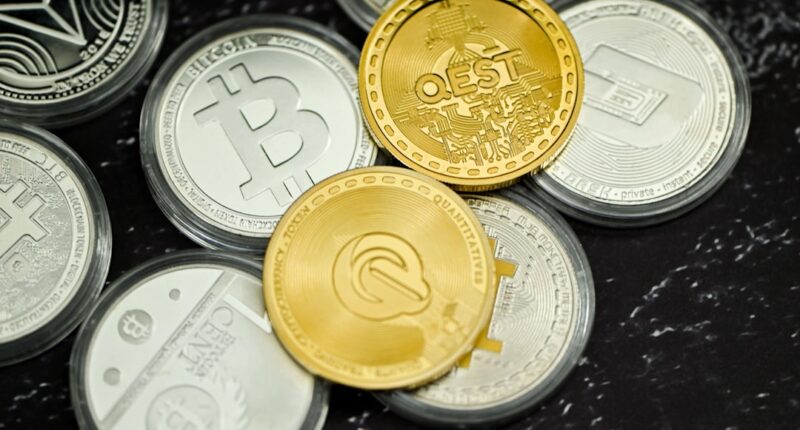The Non-Fungible Token (NFT) marketplace has emerged as a revolutionary space within the digital economy, transforming how artists, collectors, and investors interact with digital assets. NFTs are unique digital tokens that represent ownership of a specific item or piece of content, often linked to art, music, videos, and even virtual real estate. The rise of blockchain technology has enabled the creation and trading of these tokens, providing a decentralized and transparent method for verifying ownership and provenance.
As the NFT market continues to expand, it has attracted a diverse range of participants, from seasoned investors to casual creators looking to monetize their work. This dynamic landscape is characterized by a multitude of platforms, each offering distinct features and catering to various audiences. The NFT marketplace is not just a single entity but a complex ecosystem comprising various platforms that facilitate the buying, selling, and trading of NFTs.
Some platforms focus on specific niches, such as digital art or gaming assets, while others provide a more generalized marketplace for a wide array of digital collectibles. This diversity allows creators and collectors to find spaces that align with their interests and goals. However, navigating this landscape can be daunting due to the sheer volume of options available.
Understanding the nuances of each platform, including their user interfaces, community engagement, and transaction processes, is crucial for anyone looking to participate in this burgeoning market. As the NFT space continues to evolve, staying informed about trends and developments will be essential for making informed decisions.
Key Takeaways
- The NFT marketplace landscape is diverse and constantly evolving, with a wide range of platforms catering to different needs and preferences.
- When choosing an NFT selling platform, factors to consider include fees, user interface, community support, and security features.
- Popular NFT selling platforms like OpenSea, Rarible, and Foundation offer unique features such as gas-free transactions, customizable royalties, and curation of artists.
- Navigating fees and payment options on NFT selling platforms is crucial for maximizing profits and managing transaction costs.
- Evaluating the community and support on NFT selling platforms is important for networking, getting feedback, and accessing resources for success.
Factors to Consider When Choosing an NFT Selling Platform
When selecting an NFT selling platform, several critical factors come into play that can significantly impact your experience and success in the marketplace. One of the foremost considerations is the platform’s user interface and overall ease of use. A well-designed platform should provide a seamless experience for both creators and buyers, allowing users to navigate effortlessly through listings, manage their collections, and complete transactions without unnecessary complications.
Additionally, the onboarding process for new users should be straightforward, with clear instructions on how to mint NFTs and list them for sale. A user-friendly interface can make a substantial difference in attracting potential buyers and ensuring that creators can focus on their art rather than grappling with technical challenges. Another vital factor to consider is the audience and community associated with the platform.
Different NFT marketplaces attract varying demographics, which can influence the visibility and desirability of your NFTs. For instance, platforms that cater specifically to digital artists may have a more engaged audience interested in unique art pieces, while those focused on gaming might attract collectors looking for in-game assets. Understanding the target audience of a platform can help creators tailor their offerings to meet market demand effectively.
Furthermore, community engagement is essential; platforms that foster active discussions, collaborations, and feedback can enhance the overall experience for both creators and collectors. Engaging with a vibrant community can lead to increased exposure for your work and potentially higher sales.
Popular NFT Selling Platforms and Their Features

Several NFT selling platforms have gained prominence in recent years, each offering unique features that cater to different types of users. OpenSea is one of the largest and most well-known marketplaces, providing a vast array of digital assets ranging from art to virtual real estate. Its user-friendly interface allows creators to mint NFTs easily and list them for sale without extensive technical knowledge.
OpenSea supports multiple blockchains, including Ethereum and Polygon, which broadens its appeal by accommodating users who prefer different blockchain ecosystems. Additionally, OpenSea’s robust search and filtering options enable buyers to discover new artists and collections quickly, making it an attractive option for both creators and collectors. Another notable platform is Rarible, which distinguishes itself through its community-driven approach.
Rarible allows users to create and sell NFTs while also participating in governance decisions through its native token, RARI. This feature empowers users to have a say in the platform’s development and direction, fostering a sense of ownership among its community members. Rarible also offers customizable royalties for creators, ensuring they receive ongoing compensation whenever their work is resold on the platform.
This focus on creator rights has made Rarible a popular choice among artists looking for more control over their work’s monetization. By understanding the unique features of these platforms, creators can make informed decisions about where to list their NFTs.
Navigating Fees and Payment Options on NFT Selling Platforms
Understanding the fee structure associated with NFT selling platforms is crucial for creators looking to maximize their profits. Most platforms charge transaction fees or gas fees for minting and selling NFTs, which can vary significantly depending on the blockchain used and the platform’s policies. For instance, Ethereum-based platforms often have higher gas fees due to network congestion during peak times.
Creators should carefully review each platform’s fee schedule before listing their NFTs to avoid unexpected costs that could eat into their profits. Some platforms may offer promotional periods with reduced fees or even zero fees for certain transactions, making it worthwhile to stay informed about any ongoing promotions. In addition to transaction fees, payment options are another essential aspect to consider when choosing an NFT selling platform.
While many platforms primarily accept cryptocurrencies like Ethereum or Bitcoin, some have begun integrating fiat payment options to cater to a broader audience. This flexibility can be particularly beneficial for new collectors who may not be familiar with cryptocurrency transactions. Furthermore, understanding how payouts are processed is vital; some platforms may have waiting periods before funds are released after a sale is completed.
Creators should ensure they are comfortable with the payment methods offered by the platform they choose and consider how these options align with their financial goals.
Evaluating the Community and Support on NFT Selling Platforms
The community surrounding an NFT selling platform can significantly influence a creator’s success in the marketplace. A strong community fosters collaboration, networking opportunities, and support among artists and collectors alike. Platforms that prioritize community engagement often host events such as virtual exhibitions or artist showcases that allow creators to gain visibility and connect with potential buyers.
Engaging with fellow artists can also lead to valuable feedback on one’s work and insights into market trends. Therefore, when evaluating an NFT selling platform, it is essential to consider not only the features it offers but also the strength and vibrancy of its community. Support services provided by the platform are equally important in ensuring a positive user experience.
Creators may encounter technical issues or have questions about listing their NFTs; thus, responsive customer support can make a significant difference in resolving these challenges promptly. Platforms that offer comprehensive resources such as tutorials, FAQs, and live chat support demonstrate a commitment to helping users navigate the complexities of the NFT space. Additionally, active social media channels where users can seek assistance or share experiences contribute to building a supportive environment.
By assessing both community engagement and support services, creators can choose platforms that align with their needs and enhance their overall experience.
Security and Trustworthiness of NFT Selling Platforms

In an era where digital assets are increasingly targeted by cyber threats, security is paramount when selecting an NFT selling platform. Users must ensure that the platform employs robust security measures to protect their assets from hacking attempts or fraudulent activities. This includes features such as two-factor authentication (2FA), secure wallet integrations, and regular security audits conducted by third-party firms.
A trustworthy platform will transparently communicate its security protocols and any incidents that may have occurred in the past. By prioritizing security measures, creators can safeguard their NFTs and maintain confidence in their chosen marketplace. Trustworthiness also extends beyond security; it encompasses the platform’s reputation within the NFT community.
Researching user reviews and testimonials can provide valuable insights into other users’ experiences regarding reliability and customer service. Platforms with a history of successful transactions and positive feedback from users are generally more trustworthy than newer or less established options. Additionally, examining how a platform handles disputes or issues related to transactions can further inform your decision-making process.
By prioritizing security and trustworthiness when selecting an NFT selling platform, creators can protect their investments while engaging confidently in the marketplace.
Tips for Maximizing Your Success on NFT Selling Platforms
To maximize success on NFT selling platforms, creators should adopt strategic approaches that enhance visibility and engagement with potential buyers. One effective strategy is to actively promote your work across various social media channels and online communities dedicated to NFTs. Building a personal brand as an artist can significantly increase your reach; sharing behind-the-scenes content about your creative process or engaging with followers through live streams can foster deeper connections with your audience.
Collaborating with other artists or participating in joint projects can also introduce your work to new audiences while enriching your creative practice. Another essential tip is to stay informed about market trends and adapt your offerings accordingly. The NFT space is continually evolving; what may be popular today could change rapidly tomorrow.
By keeping an eye on emerging trends—such as new artistic styles or innovative uses of technology—creators can position themselves advantageously within the marketplace. Additionally, experimenting with different types of NFTs—such as limited editions or interactive pieces—can attract diverse collectors looking for unique experiences. By combining effective promotion strategies with an awareness of market dynamics, creators can enhance their chances of success on NFT selling platforms.
Making the Final Decision: Choosing the Right NFT Selling Platform for You
Ultimately, choosing the right NFT selling platform requires careful consideration of various factors that align with your goals as a creator or collector. Begin by assessing your specific needs: Are you primarily focused on selling digital art? Do you want access to a broad audience or prefer niche communities?
Understanding your priorities will help narrow down your options effectively. Additionally, take time to explore multiple platforms before making a decision; many offer free accounts that allow you to familiarize yourself with their interfaces without committing financially. As you evaluate potential platforms, weigh factors such as fees, community engagement, security measures, and support services against your personal preferences and objectives.
Engaging with existing users through forums or social media can provide valuable insights into their experiences on different platforms. Ultimately, selecting an NFT selling platform is not just about immediate sales; it’s about finding a space where you feel supported as an artist or collector while maximizing your potential for growth within this exciting digital landscape. By taking a thoughtful approach to this decision-making process, you can position yourself for success in the ever-evolving world of NFTs.
FAQs
What is an NFT selling platform?
An NFT selling platform is a digital marketplace where creators can sell their non-fungible tokens (NFTs) to buyers. These platforms provide a space for artists, musicians, and other creators to mint, list, and sell their unique digital assets as NFTs.
What factors should I consider when choosing an NFT selling platform?
When choosing an NFT selling platform, it’s important to consider factors such as fees, user interface, community support, security, and the platform’s track record for successful NFT sales. Additionally, consider the platform’s target audience and whether it aligns with your own target market.
What are some popular NFT selling platforms?
Some popular NFT selling platforms include OpenSea, Rarible, Foundation, and Mintable. Each platform offers different features and benefits, so it’s important to research and compare them to find the best fit for your NFT selling needs.
How do NFT selling platforms handle royalties for creators?
Many NFT selling platforms have built-in royalty mechanisms that automatically distribute a percentage of future sales back to the original creator. This feature ensures that creators continue to benefit from the resale of their NFTs in the secondary market.
Can I sell different types of NFTs on the same platform?
Yes, many NFT selling platforms support a variety of digital assets, including art, music, videos, and virtual real estate. Some platforms may have specific guidelines or requirements for different types of NFTs, so it’s important to review their policies before listing your assets.





